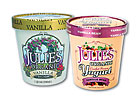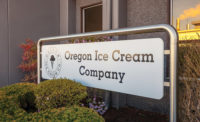
A lesson for all the husbands out there: Listen to your wife.
It’s meant success for the Oregon Ice Cream Co., a company that in the past 12 years has undergone a transformation from regional processor of square half-gallons for retail to the leading organic ice cream maker in the country, with its own booming brands and a thriving contract manufacturing business.
Not long after he and his wife acquired the company in 1996, president and chief executive officer Tom Gleason kept finding a competing superpremium in his home freezer, and continually discarded it. When Gleason confronted his wife, Julie, as to why she kept buying it, she challenged him to make a product that was more pure, wholesome and indulgent.
Thus was born Julie’s Organic, a growing line of ice cream, frozen yogurt and novelties that continues to rank among the best-selling natural and organic brands. Gleason, who came to the business with no previous dairy experience, calls his wife the brains and warmth behind the brand; among other things, she designed the packaging and came up with the flavors in the lineup.
Gleason turned to another family member in creating a more recent success: Alden’s Ice Cream, named for one of their two sons. While Julie’s comes in pints, Alden’s is offered in 48-ounce scround containers.
“We felt the category had grown to the point where it needed a family size,” Gleason says, noting that 48 ounces of organic ice cream sells for about the same price as a 56-ounce container of conventional product. “Moms that are feeding their families, they’re not going to feed a $4 pint to the kids.”
Since its launch in fall 2006, Alden’s has already become the No. 1 packaged ice cream in the natural/organic segment. “The brand is on fire,” remarks Mark Gustafson, senior executive vice president.
So, it seems, is the company in general, as it has successfully reinvented itself to keep up with changing times and an evolving industry. With more than 400 SKUs, Gleason projects sales to exceed $65 million this year, up from $45 million just two years ago and $11 million when he acquired the company.

Thinking outside the square
An Oregon native, Gleason describes his foray into the ice cream business a dozen years ago as his “midlife crisis.” At age 40, he had worked in the security electronics industry for 13 years. “I was getting tired of that industry and the corporate governance model dictating our future,” recalls Gleason, who was living in Texas at the time. “We decided it was time to move home to Oregon and buy a company.”He hastens to add that “ice cream was not even on my mind” when he sold his equity in the company he was with at the time and began investigating some 40 companies for potential acquisition. Gleason eventually met Gustafson who, with his father and brother, owned and operated Eugene-based Dutch Girl Ice Cream, which manufactured and supplied packaged ice cream for grocers in the region.
“When I saw the business, it kept me up, thinking about all the possibilities,” says Gleason, who then began researching the market. “It just excited me.”
Luckily, excitement breeds creativity. In 1996, when the Gleasons bought the company, 40 percent of its sales were for one customer, which cancelled its business six months after the acquisition. “We had to quickly recreate ourselves,” Gleason says. “We were in survival mode, but fortunately we were blessed with divine insight.”
The company refocused its sales efforts from retail to foodservice, “an area in which we thought we had a competitive advantage,” Gleason says. That advantage is sure to become more pronounced, he explains, as the ice cream industry overall becomes more national in scope while energy and transportation costs continue to rise. “Three-gallon tubs will have to come from an eight-to-10-state region to be cost-competitive,” he says.
Oregon Ice Cream focuses on eight western states with its Cascade Glacier foodservice brand, which began with about 40 flavors – mostly extensions of the original Dutch Girl business – and has since grown to more than 80, many specifically tailored for the regions in which they’re sold. For example, Gustafson says, Cascade Glacier’s Huckleberry Heaven is a top seller in the area around Yellowstone National Park, in Wyoming on the Montana border.
“We manufacture more 3-gallon tubs than anyone we know on the West Coast. We’re focusing on that as an opportunity to grow,” Gleason says, noting that more than half of the company’s business is foodservice tubs. “We have really focused not just on restaurant sales but dipping stores.”
In fact, the company’s foodservice sales team actively recruits new dip-stand businesses, and not only in traditional locations. “Anywhere you have foot traffic, you can sell cones,” Gleason says, outlining the company’s “Got 4 Feet?” campaign. “If you’ve got four feet in your business, we can show you how to get another $25,000 in business out of it. In the last six years, we’ve put 1,200 people in the dipping business. We even have helped customers put dipping stations in the most unusual places, including a floral shop, a bait store, a wood-cutting store and a coin laundry.”
Gleason believes there are many more opportunities to be mined for ice cream in the United States, noting that frozen treats can be had in many more nontraditional venues in markets abroad. “Ice cream is very underdeveloped in the United States,” he says.
And there are opportunities to make ice cream even more visible to the public. The large, 3-gallon tubs promote a “buy with your eyes” concept, Gleason explains, that appeals to consumers visually by their size, colors and chunky inclusions. “It makes you want to try something you wouldn’t normally try.”

Easier being green
That about sums up Oregon Ice Cream’s philosophy of the past decade as it continues to try out concepts that the industry wouldn’t normally try – like, for instance, extruded sorbet bars, which the company launched about a year and a half ago. The company’s quirky R&D team devised a way to extrude the fruit-based, dairy-free stick novelty, a type that is normally a molded bar. With more that 30 percent fruit solids and 60 calories, the bar ranks among the top 20 natural/organic frozen treats, according to SPINS, an information tracker for the natural products industry; of those top 20 products, Oregon Ice Cream makes eight.Another first, soon to hit the market nationally, is an addition to the Julie’s Organic line: frozen yogurt that contains not only probiotic cultures but the prebiotic fiber upon which the beneficial bacteria feed. And last fall, Julie’s launched a line of 100-calorie extruded organic vanilla ice cream sandwiches. “It’s aimed at the demographic of middle- to high-income working moms who want a treat for their kids that’s not going to mess them up for the day, or anyone who wants a low-calorie treat,” Gustafson says.
They’re the kind of products most would expect to be coming out of the Pacific Northwest, a region that has acquired a reputation for being a hotbed for environmentalists, as well as the organic and natural food lifestyle. Interestingly, Oregon Ice Cream’s move toward organics was made not so much for green reasons, but out of a desire to make a better product. “As we explored being green, we learned more than we could have ever imagined,” Gleason says. “If you can make something without chemicals that helps the environment and is better for you, logic says you should do it.”
But there were stumbling blocks, especially at a time when the organic market was a fraction of what it has since become. “Could we source enough good organic material to make a good product?” Gleason recalls wondering. Even though obtaining sufficient organic ingredients can be problematic today because of the increased demand, he says, “the requirement to contract purchase many of them a year in advance, estimating what we will grow, and if we don’t need them we have to consume these very expensive ingredients in manufacturing our conventional products, made it a more significant task a decade ago.”
Growing among giants
But as someone once said, it’s not a bad problem to have, especially when it means growth for your business – growth that has seen the number of production lines grow from one to five since 1996.And the transformation from commodity producer to niche manufacturer has brought diversification, leading to new business like making frozen bases for the Jamba Juice smoothie chain. “We redesigned bases,” Gleason says, explaining that the company took the product a few steps beyond the traditional standard base that didn’t enhance the end product. The company makes soy- and rice-based products, too. Other customers along the way have included Nestlé, Kroger, Safeway and Meijer.
Oregon Ice Cream’s R&D team keeps busy by developing new products and, when necessary, reformulating existing ones to meet changing demands for nutrition and taste. “What gives us a competitive advantage is we can go to a store group or foodservice company that asks for a product that’s nutritionally better, or better in quality and taste, then we can turnkey it from concept to finished product,” Gleason says. “We’re not Dreyer’s or Unilever and we’re never going to be. So we’re going to be masters of the small and unique – a boutique with a lot of capacity for business that’s too small for the big guys to care about.”
But the growth of those national players, forcing smaller companies to rethink their strategies or die, is among the changes Gustafson has seen in his years with the company, which his family founded in 1938. “The continued push of Dreyer’s and Breyers in the Northwest,” he observes. “In fact, we were the first Breyers distributor in Oregon. Like a lot of food products, ice cream has become a national player game more so than ever, versus a guy that used to take care of three counties.”
This evolution has seen the number of ice cream plants nationwide drop from 1,700 to about 500 in the past 20 years, Gustafson notes. “If it wasn’t for the focus of foodservice and creating something new, we wouldn’t be here,” he says. “Alden’s, Julie’s – they’re not ‘me-too’ products. They give consumers more of a choice than they ever had before.”
That growing national strength of the leading players, combined with the consolidation of the grocery industry and rapid decline of independent supermarkets that don’t reinvent themselves in some way to fill a specialty niche, have made it ever more difficult for small manufacturers to exist.
“Nationally, you’ve got two of the world’s largest food companies buying all the shelf space in supermarket freezers,” Gleason says. “They’re creating more products, buying up brands and putting new items in that space. With everybody wanting fewer SKUs to manage, it really takes away the ability of the small manufacturer to get into mainstream grocery.”
That, along with confiscatory slotting fees, has made selling retail “a large-company game,” he says. “I’ve eaten a lot of great regional products that most people won’t ever get to try. I could make the best product in the world and not be able to get it on the shelf.”
But while smaller companies may see their own brands not moving far beyond the shelves of specialty stores, a nimble co-packing operation can get them the exposure and revenues that can be had on a national level. “We have to be innovative, creative, find trends ahead of the national brands,” Gleason says.
The company’s creativity led Cadbury Schweppes to its doorstep when it sought to develop a pint ice cream line around its Green & Black organic chocolate brand. “They wanted a product unlike anything in the industry,” Gleason says. “We made them something new and unique – an ice cream that’s higher in solids than anything we’ve seen out there.”
Other projects are a-brewing, suggesting that Oregon Ice Cream’s metamorphosis has been a success. The company faces many of the same cost challenges the big guys do with less ability to absorb the impact, but possesses flexibility and a knack for seizing the right opportunity at the right time.
One other critical factor has made Oregon Ice Cream successful, Gleason says. “We spend a lot of time really listening to our customers when it comes to how we can improve products, new flavors, service and shipping, and ideas in general. All of our Web inquiries are routed by Julie, who really cares about what our customers perceive about us as a company. As Julie puts it, ‘Our greatest asset is our customers, and by meeting their needs we find greater and greater success. It is our personal touch with our customers that set us apart,’” he says.
“Our biggest challenge is, where’s the market going to be? The question as a producer is, what battle do you want to fight and what do you want to do next?”
History
The roots of the Oregon Ice Cream Co. date back to 1938, when Gustafson’s Super Creamed Ice Cream was first sold at a small story in Cottage Grove, Ore. Two years later, the Gustafson brothers purchased the Dutch Girl Dairy on Willamette Street in Eugene, starting out small – with just one truck – and focusing exclusively on ice cream. After World War II, the company expanded into a complete frozen-foods business.Gene Gustafson entered the business in 1948 after the death of his father Reuben, one of the five founding brothers. Eventually two of the brothers sold their interests in the company, leaving Gene, his mother and two uncles to run the business.
In 1955, Dutch Girl moved to a location on West Eighth Street in Eugene and constructed a new plant and freezer facilities. Gene took over management of the company in 1964; sons Mike and Mark later joined as the third generation of family management.
The Dutch Girl marketing area eventually expanded into all of Oregon, southern Washington, northern California and Alaska. In 1974, the company became a member of Quality Chekd Dairies Inc.
In 1996, Dutch Girl was acquired by Tom and Julie Gleason, with Mark Gustafson continuing to hold a stake in what has become known as the Oregon Ice Cream Co.
The Oregon Ice Cream Family of Products
Julie’s OrganicThe line that pushed the company into a new era, Julie’s Organic is ice cream made with the highest-quality certified organic cream possible. It is a complete line of more than 30 product SKUs ranging from a 15% butterfat, low-overrun line of pints, quarts and novelties, to the new 60-calorie fat-free sorbet bars, to a complete pint line of organic frozen yogurt with prebiotic and probiotic cultures. Pint flavors include Blackberry, Mint Fudge, Mocha Java, Strawberry, Chocolate, Caramel and Vanilla, among others. Novelties include vanilla and chocolate ice cream bars dipped in dark chocolate, vanilla ice cream sandwiches and smaller portion-controlled Juliettes sandwiches.
Alden’s
One of the newest products is this 48-ounce packaged premium ice cream line, one of the first family-size organic ice cream products on the market. At 13.5 percent butterfat and lower overrun than national premium ice cream lines, it comes in Vanilla Bean, Chocolate Chocolate Chip, Mint Chip, Strawberry, Blackberry and Cookies ’n Cream.
Foodservice Brands
Oregon Ice Cream manufactures a variety of dessert products designed to meet the needs of any segment of the foodservice industry. Cascade Glacier 3-gallon tubs come in nearly 80 flavors, including ice creams, sherbets, sorbets, no-sugar added ice cream, low-fat ice cream, low-carb ice cream and yogurt.
Private Label
Oregon Ice Cream manufactures extruded novelties for some of the larger grocery chains in the United States, plus 48-ounce scrounds, 3-gallon tubs in private label for foodservice, 5-quart pails, cups and other items.

